Analysis and Prediction of Spatial and Temporal Land Use Changes in the Urban Agglomeration on the Northern Slopes of the Tianshan Mountains
Abstract
1. Introduction
2. Materials and Methods
2.1. Overview of the Study Area
2.2. Data Sources
2.3. Research Methodology
2.3.1. Land Use Transfer Matrix
2.3.2. Land Use Dynamics
2.3.3. Land Use Intensity
2.3.4. Gravity Center Shift Analysis
2.3.5. Geodetector
- (1)
- Factor Detection
- (2)
- Interaction Detection
2.3.6. PLUS Model
- (1)
- LEAS
- (2)
- CARS
- (3)
- Model accuracy validation
3. Results
3.1. Analysis of the Characteristics of Land Use Transfer Areas
3.2. Analysis of the Characteristics of Changes in Land Use Dynamics
3.3. Analysis of Spatiotemporal Characteristics of Land Use Intensity Changes
3.4. Analysis of Land Use Centroid Migration
3.5. Drive Mechanism Feature Analysis
3.5.1. Factor Detection Analysis
3.5.2. Interaction Detection Feature Analysis
3.6. Land Use Projections
3.6.1. Analysis of Land Use Expansion
3.6.2. Conversion Rules
3.6.3. Model Accuracy Validation
3.6.4. Land Use Prediction
4. Discussion
5. Conclusions
- (1)
- From 2010 to 2020, cropland area in TNUA showed consistent expansion, while construction land exhibited continuous growth. Grassland coverage demonstrated an initial decline followed by recovery, mirroring the trend observed in water body. In contrast, forest area experienced persistent reduction, and unused land underwent continual contraction. Temporally, the most substantial changes occurred during 2015–2020 for cropland, forest, grassland, and unused land, whereas water body and construction land showed peak change rates during 2010–2015.
- (2)
- During the 2010–2020 period, the comprehensive land use intensity index in TNUA showed a significant increase from 157.8371 to 161.1008, demonstrating progressive intensification of anthropogenic land use activities and sustained regional development. Notably, the Shayibake District exhibited the most rapid intensification of land use among all study areas during this decade.
- (3)
- Analysis of centroid migration patterns revealed two key spatial relationships: (a) cropland displacement vectors showed strong correspondence with water body movements, reflecting the coupled development of agriculture and water resources in northern Tianshan’s oasis ecosystems; (b) construction land centroid trajectories displayed inverse directional trends relative to unused land, demonstrating urbanization-driven land conversion processes with a distinct eastward shift in urban expansion focus.
- (4)
- The driving factors showed varying influences across 2010, 2015 and 2020. Temperature, precipitation, GDP and elevation consistently remained the dominant factors affecting land use changes. Interaction analysis revealed that all factor interactions exhibited either two-factor enhancement or nonlinear enhancement effects, with neither independent nor weakening effects observed. This demonstrates that combined factors have greater explanatory power than individual factors alone.
- (5)
- Distinct sets of driving factors were identified for different land use expansions. Water body expansion showed strong associations with population density, air temperature, and elevation. Cropland expansion was principally governed by slope, elevation, nighttime light brightness, and population density. For construction land expansion, the key determinants were nighttime light, slope, and air temperature.
- (6)
- The PLUS model exhibited high predictive accuracy for simulating land use changes. Projection results indicate consistent annual declines in unused land and forest area during 2025–2035, contrasting with progressive expansion of cropland, grassland, water body, and construction land throughout the projection period.
Author Contributions
Funding
Data Availability Statement
Conflicts of Interest
Abbreviations
| PLUS | Patch-generating Land Use Simulation |
| LULC | Land Use and Land Cover |
| TNUA | The Urban Agglomeration on the Northern Slopes of the Tianshan Mountains |
| LEAS | Land Expansion Analysis Strategy (LEAS) |
| CARS | CA based on Multiple Random Seeds |
| FOM | Figure of Merit |
References
- Chen, M.; Xian, Y.; Wang, P.; Ding, Z. Climate change and multi-dimensional sustainable urbanization. J. Geogr. Sci. 2021, 31, 1328–1348. [Google Scholar] [CrossRef]
- Fang, C.; Gao, Q.; Zhang, X.; Cheng, W. Spatiotemporal characteristics of the expansion of an urban agglomeration and its effect on the eco-environment: Case study on the northern slope of the Tianshan Mountains. Sci. China Earth Sci. 2019, 62, 1461–1472. [Google Scholar] [CrossRef]
- Ellis, E.C. Land use and ecological change: A 12,000-year history. Annu. Rev. Environ. Resour. 2021, 46, 1–33. [Google Scholar] [CrossRef]
- Nebie, E.K.; West, C.T. Migration and land-use and land-cover change in Burkina Faso: A comparative case study. J. Polit. Ecol. 2019, 26, 614–632. [Google Scholar]
- Msofe, N.K.; Sheng, L.; Lyimo, J. Land use change trends and their driving forces in the Kilombero Valley Floodplain, Southeastern Tanzania. Sustainability 2019, 11, 505. [Google Scholar] [CrossRef]
- Chisanga, C.B.; Phiri, D.; Mubanga, K.H. Multi-decade land cover/land use dynamics and future predictions for Zambia: 2000–2030. Discov. Environ. 2024, 2, 38. [Google Scholar] [CrossRef]
- Lambin, E.F.; Turner, B.L.; Geist, H.J.; Agbola, S.B.; Angelsen, A.; Bruce, J.W.; Coomes, O.T.; Dirzo, R.; Fischer, G.; Folke, C.; et al. The causes of land-use and land-cover change: Moving beyond the myths. Glob. Environ. Change 2001, 11, 261–269. [Google Scholar] [CrossRef]
- Allan, A.; Soltani, A.; Abdi, M.H.; Zarei, M. Driving forces behind land use and land cover change: A systematic and bibliometric review. Land 2022, 11, 1222. [Google Scholar] [CrossRef]
- Wu, H.; Lin, A.; Xing, X.; Song, D.; Li, Y. Identifying core driving factors of urban land use change from global land cover products and POI data using the random forest method. Int. J. Appl. Earth Obs. Geoinf. 2021, 103, 102475. [Google Scholar] [CrossRef]
- Peng, K.; Jiang, W.; Ling, Z.; Hou, P.; Deng, Y. Evaluating the potential impacts of land use changes on ecosystem service value under multiple scenarios in support of SDG reporting: A case study of the Wuhan urban agglomeration. J. Clean. Prod. 2021, 307, 127321. [Google Scholar] [CrossRef]
- Zhang, P.; Liu, L.; Yang, L.; Zhao, J.; Li, Y.; Qi, Y.; Ma, X.; Cao, L. Exploring the response of ecosystem service value to land use changes under multiple scenarios coupling a mixed-cell cellular automata model and system dynamics model in Xi’an, China. Ecol. Indic. 2023, 147, 110009. [Google Scholar] [CrossRef]
- Pijanowski, B.C.; Brown, D.G.; Shellito, B.A.; Manik, G.A. Using neural networks and GIS to forecast land use changes: A land transformation model. Comput. Environ. Urban Syst. 2002, 26, 553–575. [Google Scholar] [CrossRef]
- Gharaibeh, A.; Shaamala, A.; Obeidat, R.; Al-Kofahi, S. Improving land-use change modeling by integrating ANN with Cellular Automata-Markov Chain model. Heliyon 2020, 6, e04824. [Google Scholar] [CrossRef]
- Doelman, J.C.; Stehfest, E.; Tabeau, A.; van Meijl, H.; Lassaletta, L.; Gernaat, D.E.; Hermans, K.; Harmsen, M.; Daioglou, V.; Biemans, H.; et al. Exploring SSP land-use dynamics using the IMAGE model: Regional and gridded scenarios of land-use change and land-based climate change mitigation. Glob. Environ. Change 2018, 48, 119–135. [Google Scholar] [CrossRef]
- Leta, M.K.; Demissie, T.A.; Tränckner, J. Modeling and prediction of land use land cover change dynamics based on land change modeler (LCM) in Nashe watershed, upper Blue Nile basin, Ethiopia. Sustainability 2021, 13, 3740. [Google Scholar] [CrossRef]
- Koko, A.F.; Han, Z.; Wu, Y.; Abubakar, G.A.; Bello, M. Spatiotemporal land use/land cover mapping and prediction based on hybrid modeling approach: A case study of Kano Metropolis, Nigeria (2020–2050). Remote Sens. 2022, 14, 6083. [Google Scholar] [CrossRef]
- Avtar, R.; Rinamalo, A.V.; Umarhadi, D.A.; Gupta, A.; Khedher, K.M.; Yunus, A.P.; Singh, B.P.; Kumar, P.; Sahu, N.; Sakti, A.D. Land use change and prediction for valuating carbon sequestration in Viti Levu island, Fiji. Land 2022, 11, 1274. [Google Scholar] [CrossRef]
- Liang, X.; Guan, Q.; Clarke, K.C.; Liu, S.; Wang, B.; Yao, Y. Understanding the drivers of sustainable land expansion using a patch-generating land use simulation (PLUS) model: A case study in Wuhan, China. Comput. Environ. Urban Syst. 2021, 85, 101569. [Google Scholar] [CrossRef]
- National Development and Reform Commission Office. Notice on Accelerating the Compilation of Urban Agglomeration Planning; National Development and Reform Commission: Beijing, China, 2016. [Google Scholar]
- GS(2020)4619; Standard Map of China. Ministry of Natural Resources of the People’s Republic of China: Beijing, China, 2020.
- Li, X.; Zhou, Y.; Zhao, M.; Zhao, X. A harmonized global nighttime light dataset 1992–2018. Sci. Data 2020, 7, 168. [Google Scholar] [CrossRef]
- Wang, J.F.; Xu, C.D. Geodetector: Principle and prospective. Acta Geogr. Sin. 2017, 72, 116–134. [Google Scholar]
- Zhuang, D.; Liu, J. Study on the model of regional differentiation of land use degree in China. J. Nat. Resour. 1997, 12, 105–111. [Google Scholar]
- Department of Natural Resources of Xinjiang Uygur Autonomous Region. The 14th Five-Year Plan for the Protection and Development of Land Resources in Xinjiang Uygur Autonomous Region; Department of Natural Resources of Xinjiang Uygur Autonomous Region: Urumqi, China, 2021. [Google Scholar]
- Department of Natural Resources of Xinjiang Uygur Autonomous Region. Revised and Simplified Version of the General Land Use Plan of Xinjiang Uygur Autonomous Region (2006–2020); Department of Natural Resources of Xinjiang Uygur Autonomous Region: Urumqi, China, 2018. [Google Scholar]
- Li, X.; Qin, D.; He, X.; Wang, C.; Yang, G.; Li, P.; Liu, B.; Gong, P.; Yang, Y. Spatial and temporal changes in land use and landscape pattern evolution in the economic belt of the Northern Slope of the Tianshan Mountains in China. Sustainability 2024, 16, 7003. [Google Scholar] [CrossRef]
- Department of Ecology and Environment of Xinjiang Uygur Autonomous Region. The 14th Five-Year Plan for Ecological Environmental Protection in Xinjiang; Department of Ecology and Environment of Xinjiang Uygur Autonomous Region: Urumqi, China, 2022. [Google Scholar]
- Zhao, Y.; Kasimu, A.; Gao, P.; Liang, H. Spatiotemporal changes in the urban landscape pattern and driving forces of LUCC characteristics in the urban agglomeration on the Northern Slope of the Tianshan Mountains from 1995 to 2018. Land 2022, 11, 1745. [Google Scholar] [CrossRef]
- Shahbazian, Z.; Faramarzi, M.; Rostami, N.; Mahdizadeh, H. Integrating logistic regression and cellular automata–Markov models with the experts’ perceptions for detecting and simulating land use changes and their driving forces. Environ. Monit. Assess. 2019, 191, 422. [Google Scholar] [CrossRef]
- Buya, S.; Tongkumchum, P.; Owusu, B.E. Modelling of land-use change in Thailand using binary logistic regression and multinomial logistic regression. Arab. J. Geosci. 2020, 13, 437. [Google Scholar] [CrossRef]
- Braimoh, A.K.; Onishi, T. Spatial determinants of urban land use change in Lagos, Nigeria. Land Use Policy 2007, 24, 502–515. [Google Scholar] [CrossRef]
- Zhang, J.; Liu, Z.; Li, S. Research on land use simulation of incorporating historical information into the FLUS model—Setting Songyuan City as an example. Sustainability 2022, 14, 3828. [Google Scholar] [CrossRef]
- Wang, Y.; Shen, J.; Yan, W.; Chen, C. Backcasting approach with multi-scenario simulation for assessing effects of land use policy using GeoSOS-FLUS software. MethodsX 2019, 6, 1384–1397. [Google Scholar] [CrossRef]
- Liu, P.; Hu, Y.; Jia, W. Land use optimization research based on FLUS model and ecosystem services–setting Jinan City as an example. Urban Clim. 2021, 40, 100984. [Google Scholar] [CrossRef]
- Li, D.; Chang, Y.; Simayi, Z.; Yang, S. Multi-scenario dynamic simulation of urban agglomeration development on the northern slope of the Tianshan Mountains in Xinjiang, China, with the goal of high-quality urban construction. Sustainability 2022, 14, 6862. [Google Scholar] [CrossRef]
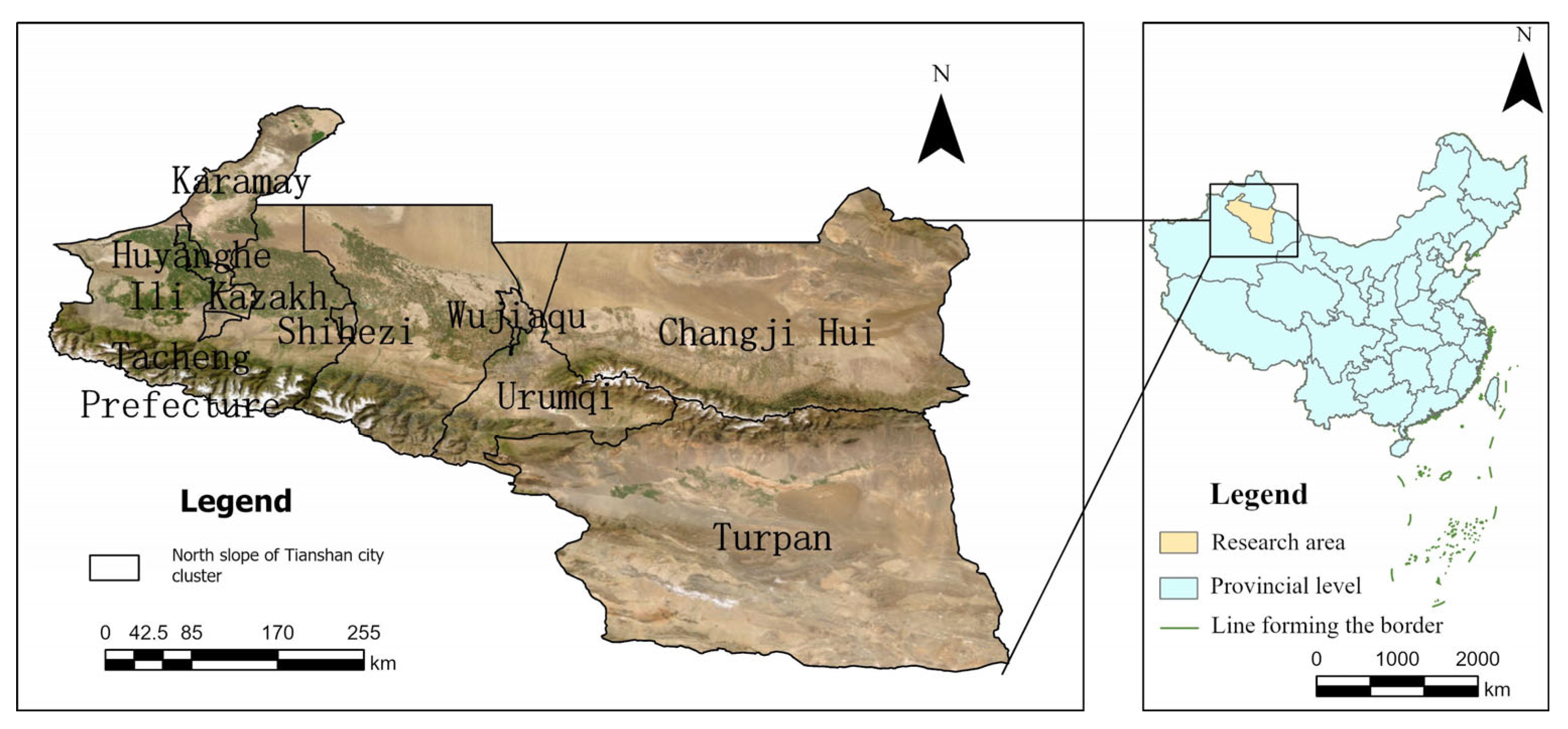
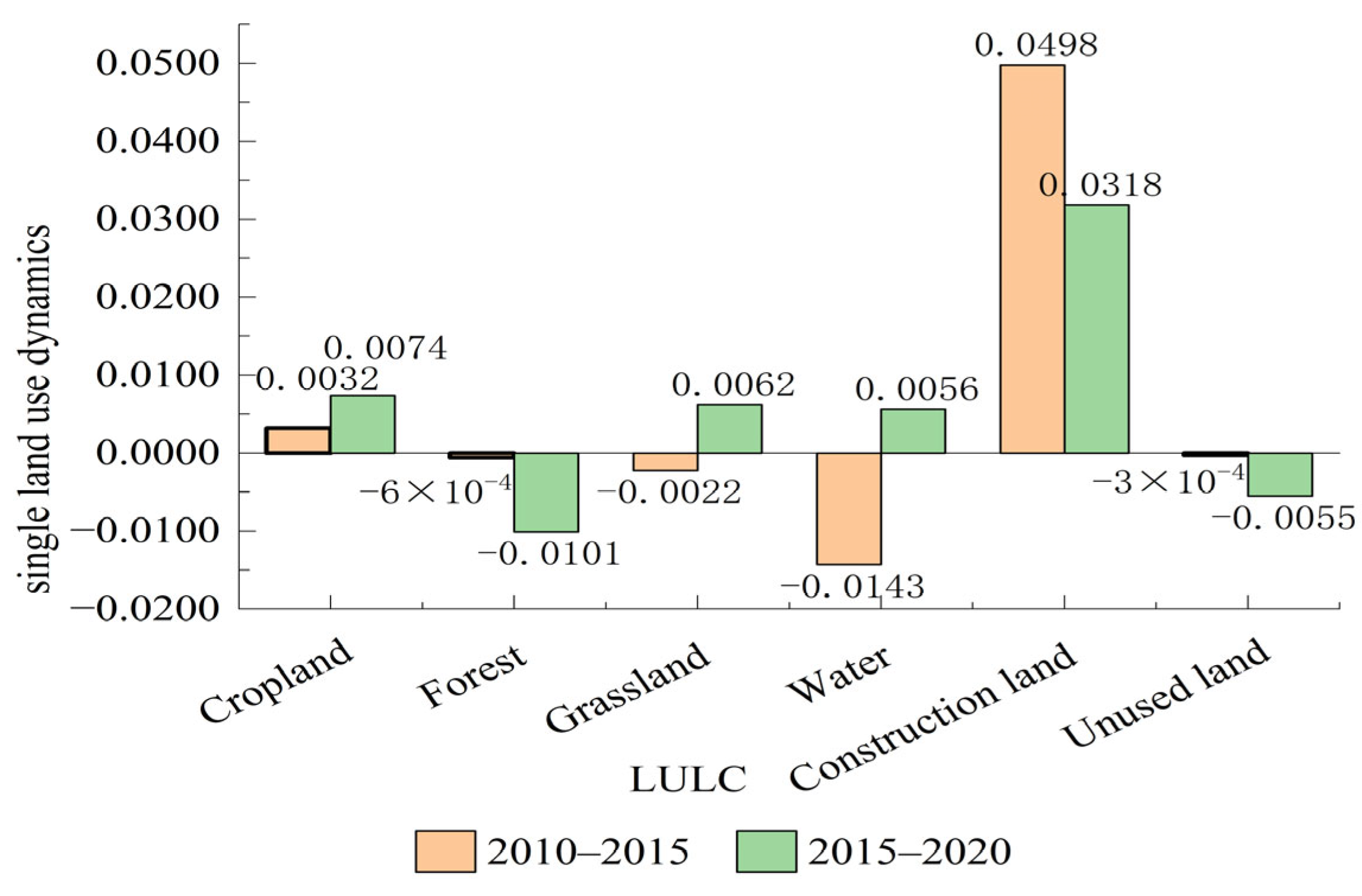
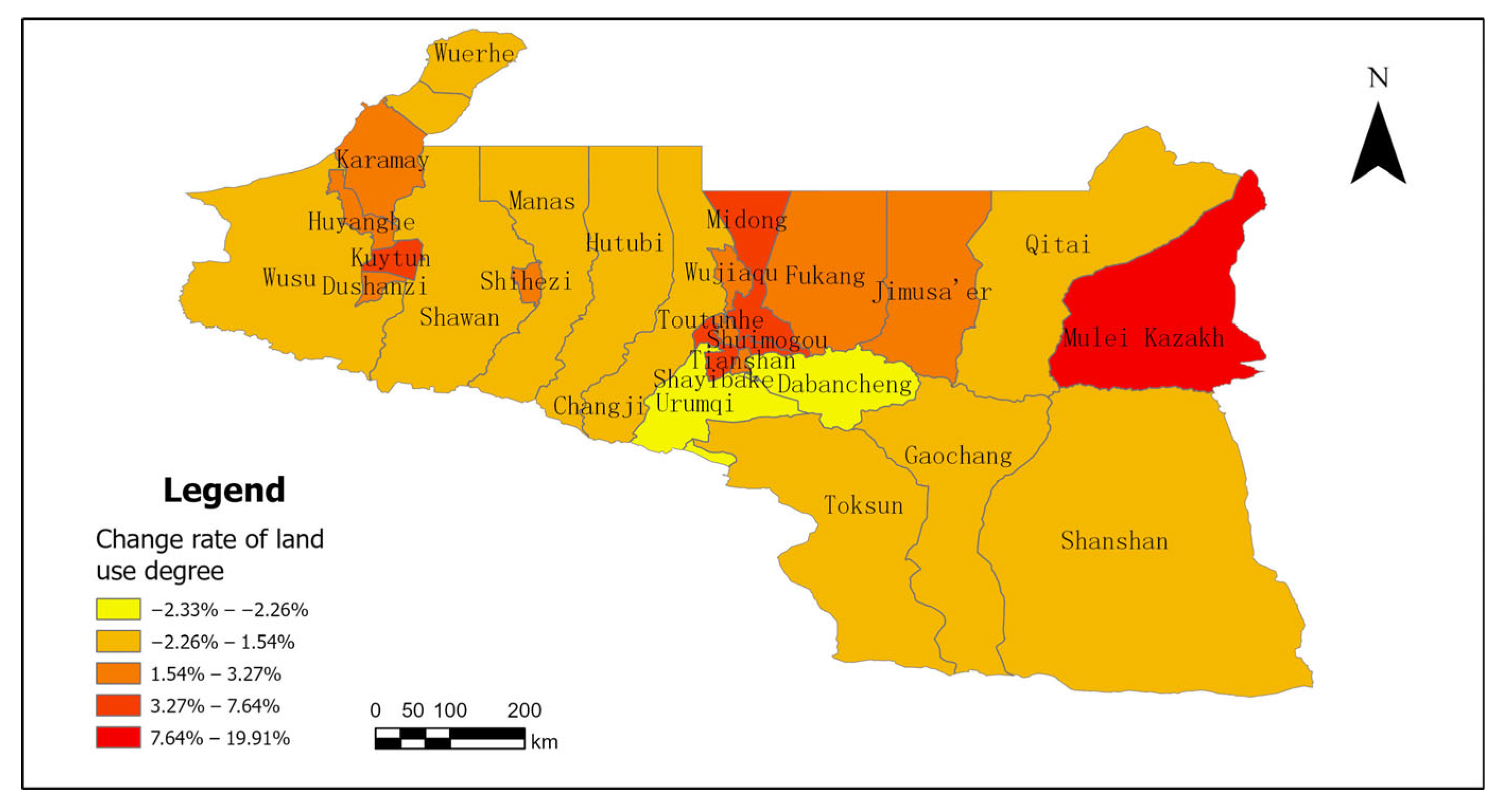
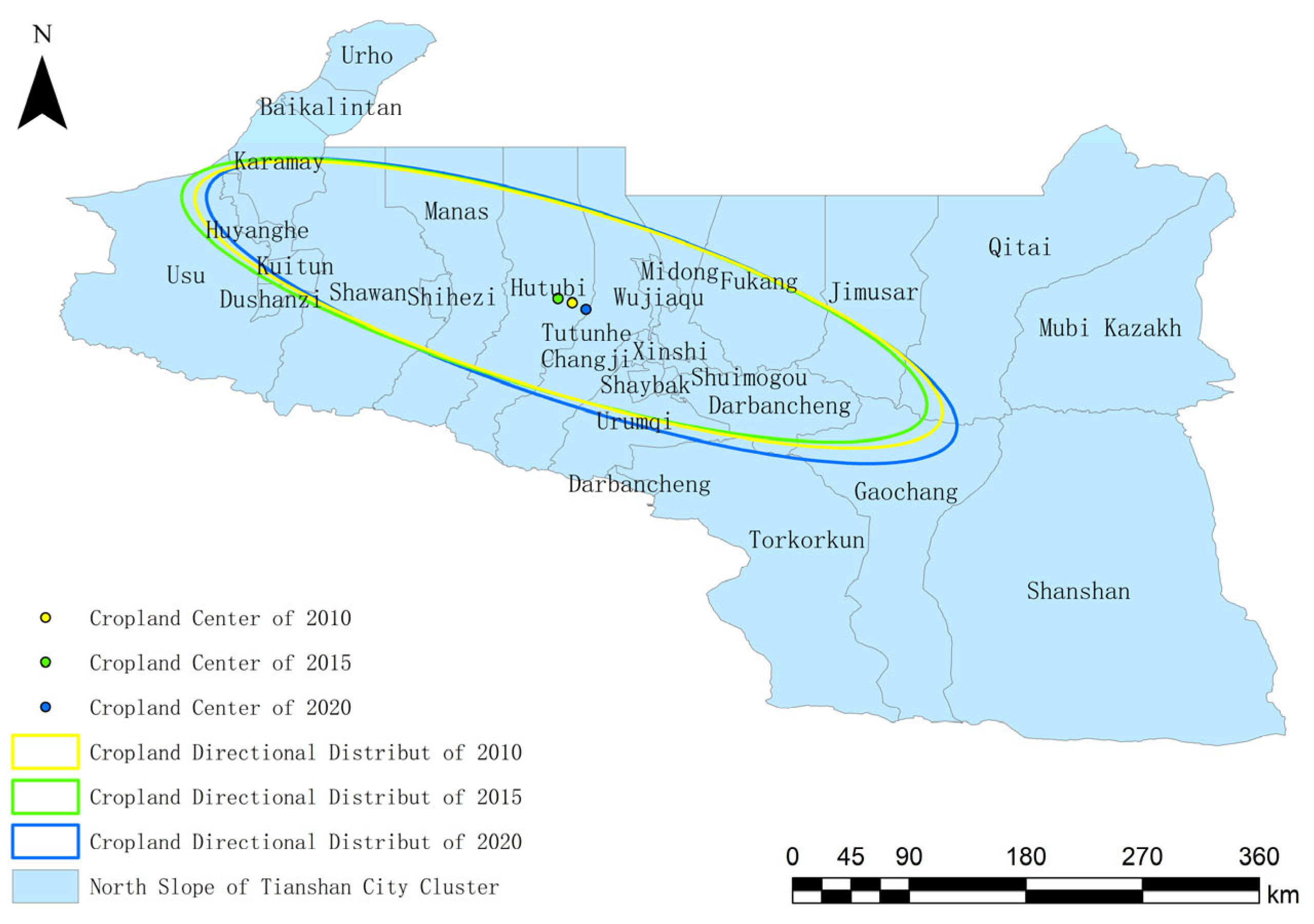
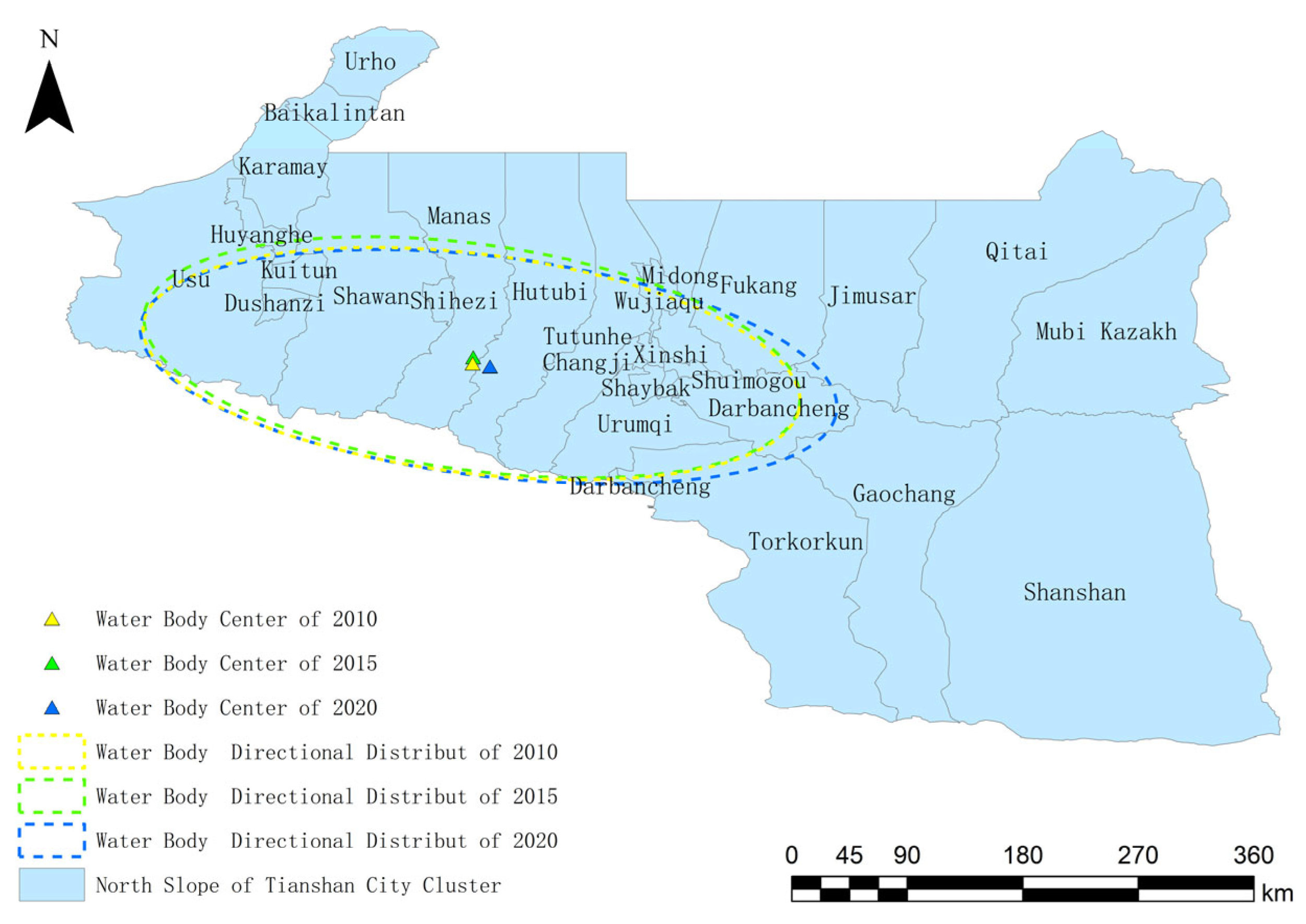
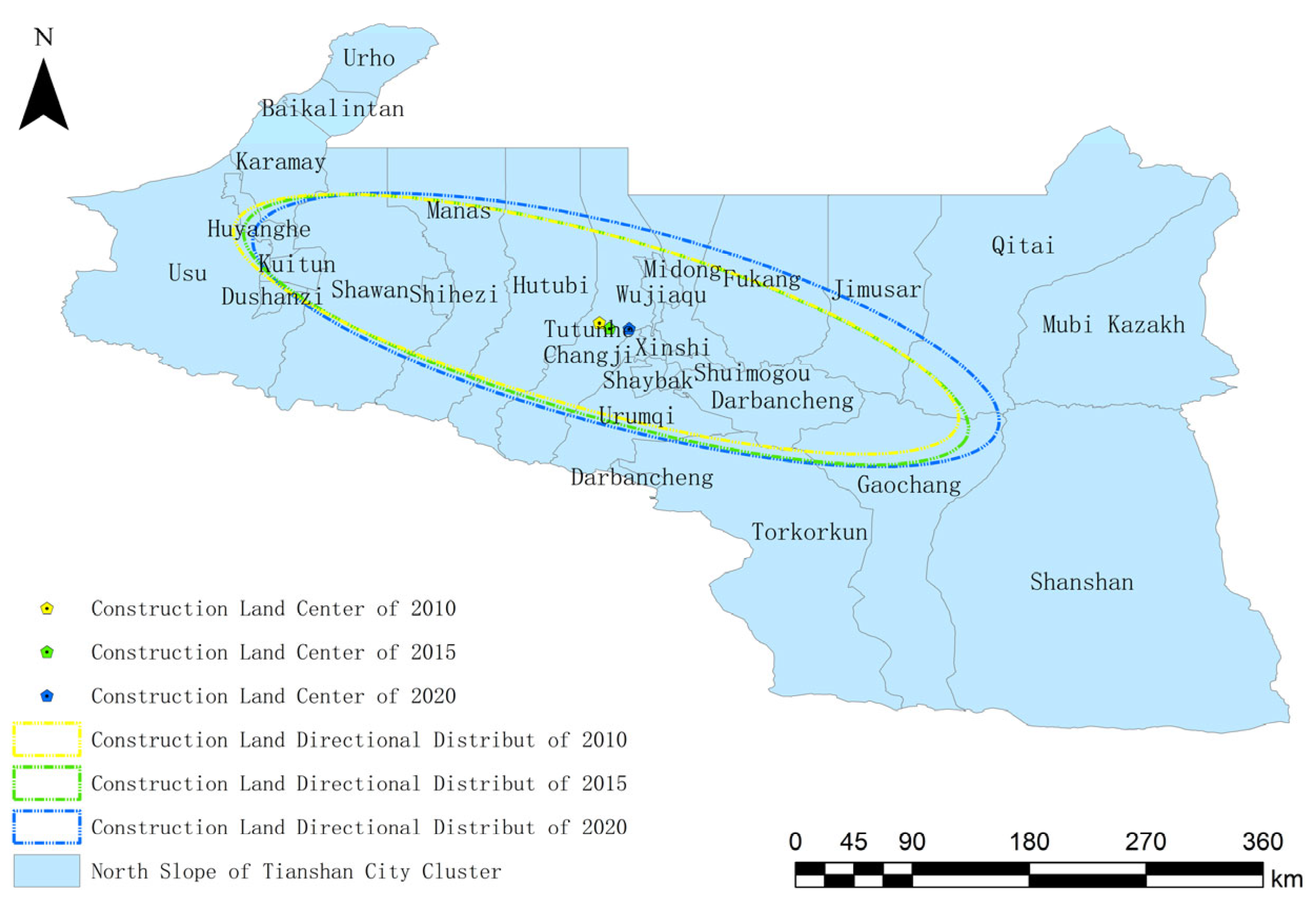
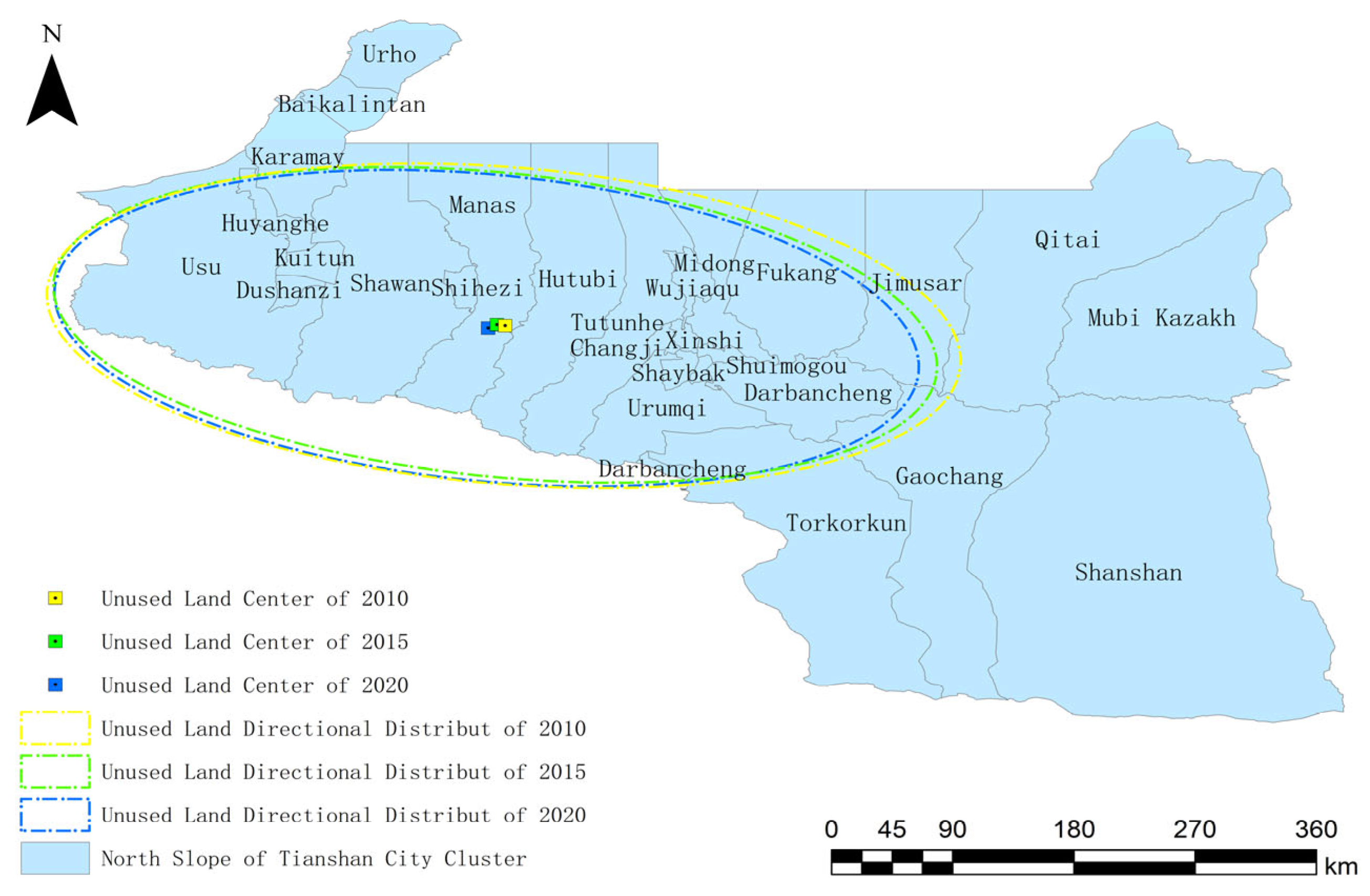
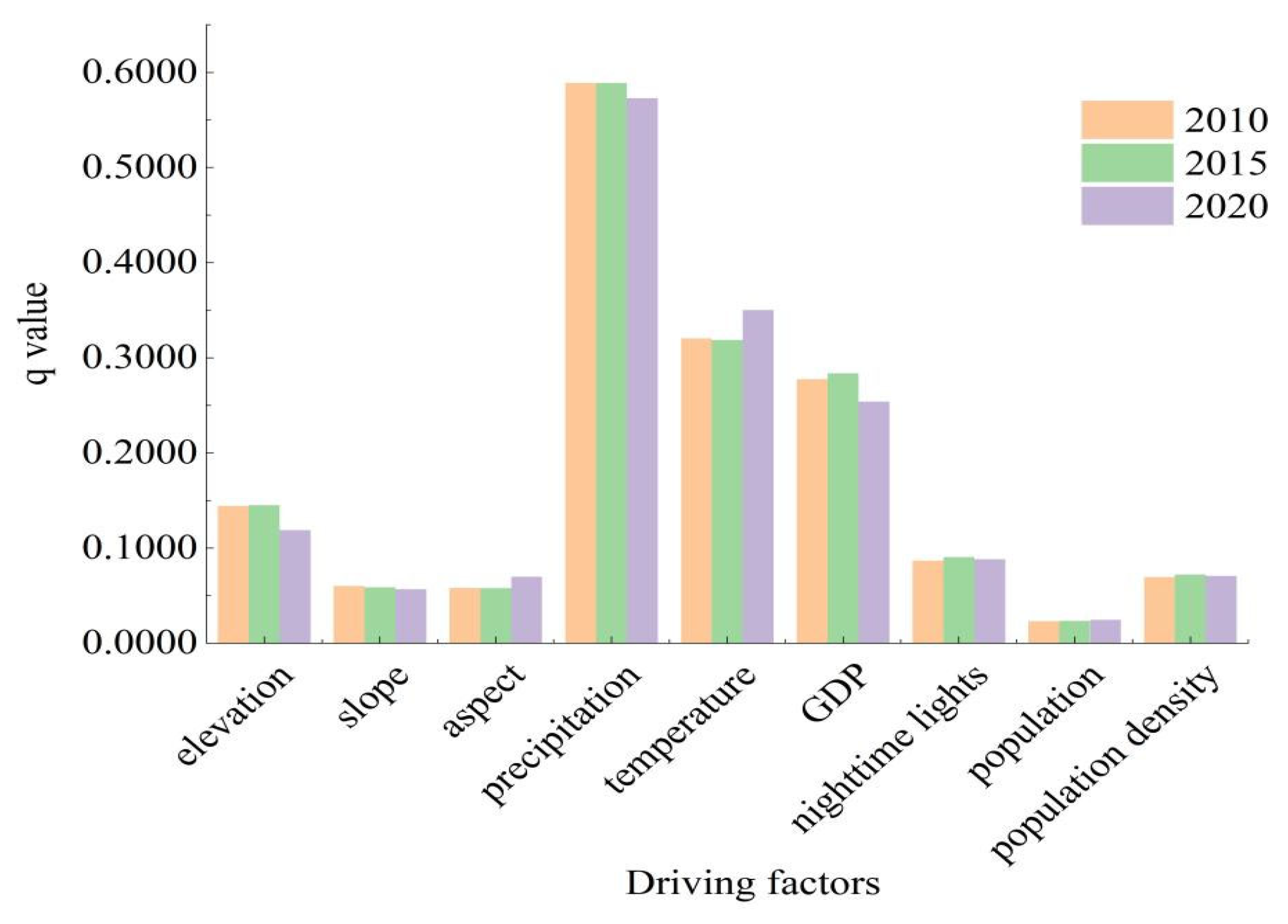

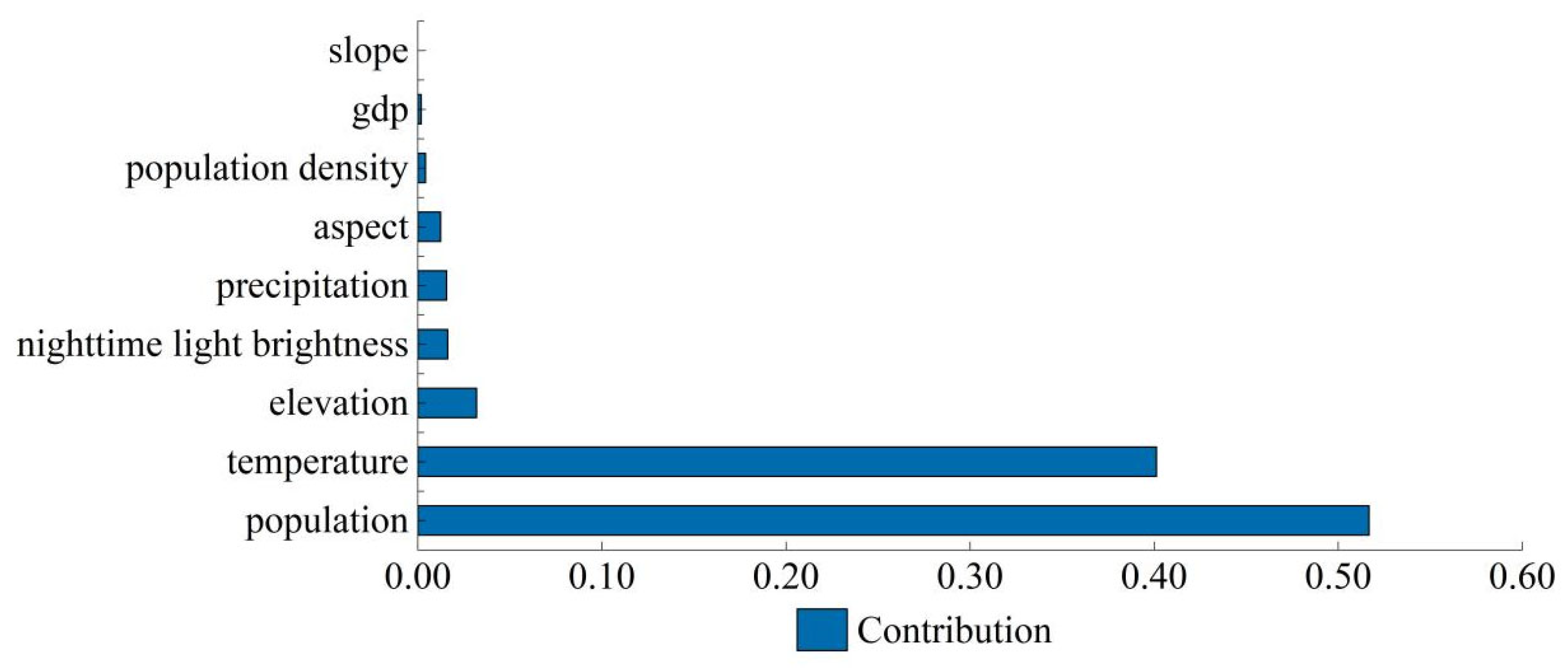
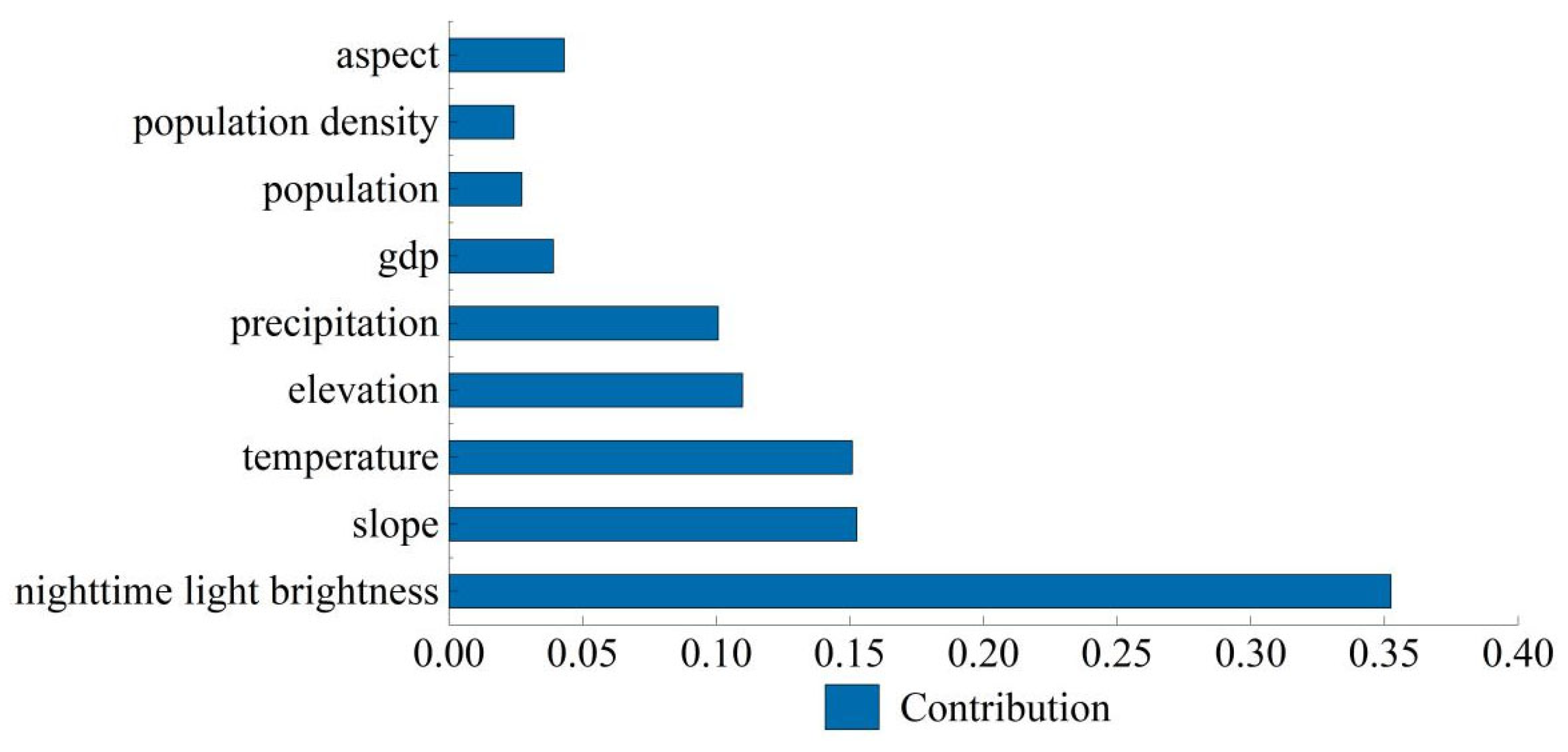





| Data | Source | Resolution | Time |
|---|---|---|---|
| LULC | Resource and Environmental Science Data Center (https://www.resdc.cn, accessed on 10 May 2024) | 30 m | 2010, 2015, 2020 |
| DEM | NASADEM (https://search.earthdata.nasa.gov/search, accessed on 8 March 2024) | 30 m | 2010, 2015, 2020 |
| Temperature | National Earth System Science Data Center, National Science & Technology Infrastructure of China (http://www.geodata.cn, accessed on 10 May 2024) | 1 km | 2010, 2015, 2020 |
| Precipitation | National Earth System Science Data Center, National Science & Technology Infrastructure of China (http://www.geodata.cn, accessed on 10 May 2024) | 1 km | 2010, 2015, 2020 |
| Nighttime Light | Dataset produced by Li et al. [21]. | 1 km | 2010, 2015, 2020 |
| Population | LandScan (https://landscan.ornl.gov, accessed on 5 April 2024) | 1 km | 2010, 2015, 2020 |
| Population Density | SEDAC (http://sedac.ciesin.columbia.edu/data/sets/browse, accessed on 5 April 2024) | 1 km | 2010, 2015, 2020 |
| GDP | Resource and Environmental Science Data Center (http://www.resdc.cn, accessed on 10 May 2024) | 1 km | 2010, 2015, 2020 |
| Land Use Type | 2010 | 2015 | 2020 |
|---|---|---|---|
| Grassland | 11.01% | 11.18% | 11.59% |
| Cropland | 1.41% | 1.41% | 1.33% |
| Construction Land | 29.84% | 29.51% | 30.43% |
| Forest | 0.95% | 0.88% | 0.90% |
| Water Body | 1.21% | 1.51% | 1.75% |
| Unused Land | 55.59% | 55.52% | 54.00% |
| Land Use Type | 2010/(km2) | ||||||
|---|---|---|---|---|---|---|---|
| Grassland | Cropland | Construction Land | Forest | Water Body | Unused Land | ||
| 2015/ (km2) | Grassland | 56,776.7077 | 306.0845 | 1.8871 | 55.5176 | 54.3660 | 48.2947 |
| Cropland | 728.5756 | 20,906.7010 | 10.7659 | 0.5243 | 2.7089 | 37.4830 | |
| Construction Land | 250.3186 | 125.2217 | 2330.5387 | 0.0773 | 50.2723 | 172.5248 | |
| Forest | 47.5660 | 0.5651 | 0.0877 | 2677.5196 | 0.2642 | 1.0095 | |
| Water Body | 32.9344 | 2.4662 | 0.1192 | 0.1957 | 1643.7436 | 23.3648 | |
| Unused Land | 49.9776 | 7.6132 | 1.4194 | 1.1296 | 82.1346 | 107,553.3705 | |
| Land Use Type | 2015/(km2) | ||||||
|---|---|---|---|---|---|---|---|
| Grassland | Cropland | Construction Land | Forest | Water Body | Unused Land | ||
| 2020/ (km2) | Grassland | 54,177.8318 | 419.8256 | 152.9080 | 257.3754 | 36.7827 | 3977.8195 |
| Cropland | 1350.4454 | 20,946.5873 | 61.6569 | 10.2370 | 12.2234 | 104.7346 | |
| Construction Land | 373.3330 | 280.8952 | 2486.7091 | 7.2315 | 7.0008 | 238.8655 | |
| Forest | 144.8710 | 4.0218 | 0.2350 | 2436.6360 | 0.6174 | 2.0698 | |
| Water Body | 62.4343 | 7.5482 | 4.2883 | 0.5660 | 1586.4390 | 89.5112 | |
| Unused Land | 1133.9669 | 27.8757 | 223.1561 | 14.9601 | 59.7061 | 103,282.5630 | |
| Land Use Type | 2010/(km2) | ||||||
|---|---|---|---|---|---|---|---|
| Grassland | Cropland | Construction Land | Forest | Water | Unused Land | ||
| 2020/ (km2) | Grassland | 54,228.9143 | 436.2549 | 26.9745 | 278.0141 | 79.8691 | 3980.3302 |
| Cropland | 1794.9387 | 20,500.4780 | 43.3549 | 8.4241 | 13.5532 | 125.1516 | |
| Construction Land | 522.0101 | 381.9949 | 2151.8315 | 7.2551 | 22.3603 | 308.5832 | |
| Forest | 155.6227 | 4.2258 | 0.2599 | 2425.3521 | 0.6594 | 2.3816 | |
| Water | 53.2246 | 8.0804 | 0.3961 | 0.5779 | 1637.7597 | 50.7860 | |
| Unused Land | 1139.1888 | 17.6328 | 122.0011 | 15.3873 | 79.2756 | 10,3369.1309 | |
| Composite Land Use Extent Index | |||||
|---|---|---|---|---|---|
| Administrative Region | 2010 | 2015 | 2020 | Change in Land Use Degree | Rate of Change in Land Use Degree |
| Urban Agglomeration | 157.8371 | 158.6845 | 161.1008 | 3.2637 | 2.0677% |
| Xinshi District | 345.3645 | 346.8406 | 355.4607 | 10.0962 | 2.9233% |
| Toutunhe District | 315.6649 | 326.9212 | 329.2754 | 13.6105 | 4.3117% |
| Shihezi City | 297.7073 | 302.2162 | 307.0561 | 9.3488 | 3.1403% |
| Shayibake District | 274.6081 | 287.9439 | 295.6105 | 21.0024 | 7.6481% |
| Tianshan District | 289.3955 | 290.1914 | 294.3987 | 5.0032 | 1.7288% |
| Kuytun City | 265.1272 | 272.1123 | 278.3592 | 13.2320 | 4.9908% |
| Huyanghe City | 270.3737 | 273.1523 | 278.1760 | 7.8023 | 2.8857% |
| Wujiaqu City | 253.4753 | 258.0132 | 259.8552 | 6.3798 | 2.5170% |
| Shuimogou District | 242.6903 | 239.4248 | 256.2122 | 13.5219 | 5.5717% |
| Dushanzi District | 227.9639 | 241.0418 | 235.4280 | 7.4640 | 3.2742% |
| Shawan County | 209.9477 | 210.8923 | 213.1988 | 3.2511 | 1.5485% |
| Urumqi County | 202.1791 | 201.8844 | 197.6061 | −4.5730 | −2.2618% |
| Wusu City | 194.0873 | 195.0096 | 196.9205 | 2.8332 | 1.4597% |
| Hutubi County | 193.3389 | 194.6834 | 195.1567 | 1.8177 | 0.9402% |
| Kelamayi District | 190.6904 | 192.3988 | 194.6975 | 4.0072 | 2.1014% |
| Changji City | 193.4780 | 196.2855 | 193.4111 | −0.0669 | −0.0346% |
| Manasi County | 187.3351 | 187.7440 | 188.6793 | 1.3443 | 0.7176% |
| Dabancheng District | 182.2912 | 182.1222 | 178.0264 | −4.2648 | −2.3396% |
| Jinghe County | 167.7866 | 169.0984 | 172.4708 | 4.6842 | 2.7918% |
| Mulei Kazakh Autonomous County | 137.8569 | 137.5752 | 165.3166 | 27.4597 | 19.9190% |
| Midong District | 155.1234 | 155.6633 | 161.6136 | 6.4902 | 4.1839% |
| Fukang City | 153.4999 | 155.5753 | 157.1198 | 3.6199 | 2.3582% |
| Qitai County | 152.1660 | 152.2463 | 151.9572 | −0.2088 | −0.1372% |
| Baiyantan District | 148.4854 | 155.4737 | 149.1833 | 0.6978 | 0.4700% |
| Gaochang District | 133.4782 | 134.0100 | 134.4197 | 0.9416 | 0.7054% |
| Tuokexun County | 131.5950 | 132.9378 | 132.4969 | 0.9019 | 0.6854% |
| Wuerhe District | 126.1526 | 127.0048 | 127.3702 | 1.2175 | 0.9651% |
| Shanshan County | 111.4130 | 111.4492 | 111.6534 | 0.2404 | 0.2158% |
| Land Use Type | Cropland | Forest | Grassland | Water Body | Construction Land | Unused Land |
|---|---|---|---|---|---|---|
| Cropland | 1 | 1 | 1 | 1 | 1 | 1 |
| Forest | 1 | 1 | 1 | 0 | 1 | 1 |
| Grassland | 1 | 1 | 1 | 1 | 1 | 1 |
| Water Body | 0 | 0 | 1 | 1 | 0 | 0 |
| Construction Land | 1 | 1 | 1 | 0 | 1 | 1 |
| Unused Land | 1 | 1 | 1 | 1 | 1 | 1 |
| Land Use Type | Cropland | Forest | Grassland | Water Body | Construction Land | Unused Land |
|---|---|---|---|---|---|---|
| Weight | 0.5631 | 0.0982 | 0.9959 | 0.2152 | 0.8899 | 0.1909 |
| Land Use Type | Projections for 2020 | ||||||
|---|---|---|---|---|---|---|---|
| Cropland | Forest | Grassland | Water Body | Construction Land | Unused Land | ||
| 2020 Actual | Cropland | 2103 | 2 | 50 | 2 | 21 | 7 |
| Forest | 0 | 253 | 35 | 0 | 0 | 1 | |
| Grassland | 138 | 17 | 5414 | 7 | 31 | 102 | |
| Water Body | 2 | 0 | 8 | 160 | 0 | 3 | |
| Construction Land | 7 | 1 | 49 | 1 | 243 | 27 | |
| Unused Land | 13 | 0 | 398 | 7 | 23 | 10,362 | |
| Land Use Projections by Year | Cropland | Forest | Grassland | Water Body | Construction Land | Unused Land |
|---|---|---|---|---|---|---|
| 2025 | 23,379 | 2435 | 60,641 | 1822 | 3744 | 101,978 |
| 2030 | 24,234 | 2324 | 62,063 | 1883 | 4088 | 99,407 |
| 2035 | 25,098 | 2229 | 63,337 | 1941 | 4395 | 97,000 |
Disclaimer/Publisher’s Note: The statements, opinions and data contained in all publications are solely those of the individual author(s) and contributor(s) and not of MDPI and/or the editor(s). MDPI and/or the editor(s) disclaim responsibility for any injury to people or property resulting from any ideas, methods, instructions or products referred to in the content. |
© 2025 by the authors. Licensee MDPI, Basel, Switzerland. This article is an open access article distributed under the terms and conditions of the Creative Commons Attribution (CC BY) license (https://creativecommons.org/licenses/by/4.0/).
Share and Cite
He, X.; Yan, Z.; Shi, Y.; Wei, Z.; Liu, Z.; He, R. Analysis and Prediction of Spatial and Temporal Land Use Changes in the Urban Agglomeration on the Northern Slopes of the Tianshan Mountains. Land 2025, 14, 1123. https://doi.org/10.3390/land14051123
He X, Yan Z, Shi Y, Wei Z, Liu Z, He R. Analysis and Prediction of Spatial and Temporal Land Use Changes in the Urban Agglomeration on the Northern Slopes of the Tianshan Mountains. Land. 2025; 14(5):1123. https://doi.org/10.3390/land14051123
Chicago/Turabian StyleHe, Xiaoxu, Zhaojin Yan, Yicong Shi, Zhe Wei, Zhijie Liu, and Rong He. 2025. "Analysis and Prediction of Spatial and Temporal Land Use Changes in the Urban Agglomeration on the Northern Slopes of the Tianshan Mountains" Land 14, no. 5: 1123. https://doi.org/10.3390/land14051123
APA StyleHe, X., Yan, Z., Shi, Y., Wei, Z., Liu, Z., & He, R. (2025). Analysis and Prediction of Spatial and Temporal Land Use Changes in the Urban Agglomeration on the Northern Slopes of the Tianshan Mountains. Land, 14(5), 1123. https://doi.org/10.3390/land14051123








